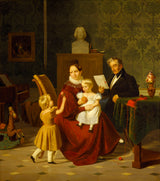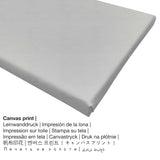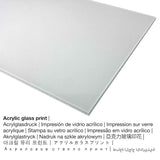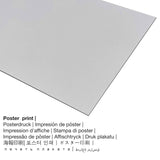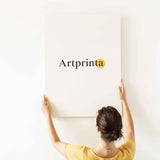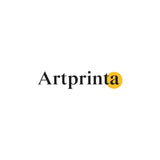Albert Küchler, 1838 - Colonel na Oriakụ Paulsen - ọmarịcha nka
Ụtụ gụnyere. Mbupu gbakọrọ na ndenye ọpụpụ.
Nkọwa nke ihe ahụ
Colonel and Mrs Paulsen bụ ọrụ nka nke onye nka mere Albert Küchler n'afọ 1838. Ihe osise a tụrụ nha: 71,9 x 64,8 cm. Mmanụ na kwaaji was used by the artist as the technique for the masterpiece. This artwork belongs to the Thorvaldsens Museum's art collection, which is a single-artist museum dedicated to the art of Danish neoclassicistic sculptor Bertel Thorvaldsen. The ngalaba ọha artwork na-nyere na n'ikike nke Albert Küchler, Colonel and Mrs Paulsen, 1838, Thorvaldsens Museum, www.thorvaldsensmuseum.dk.Ebe E Si Nweta nke ihe osise:. Ndozi n'ime Eserese format ya na oke nke 1: 1.2, nke pụtara na ogologo 20% dị mkpụmkpụ karịa obosara.
Nhọrọ akụrụngwa ngwaahịa gị
Ndepụta ndetu ngwaahịa na-enye gị ohere ịhọrọ nha na akụrụngwa nke gị. Anyị na-ahapụ gị ka ịhọrọ n'ime ụdị ndị a:
- Metal (aluminium debond mbipụta): This is a metal print manufactured on aluminium dibond material with a true depth effect. A non-reflective surface structure creates a modern look. The white & bright parts of the original artpiece shimmer with a silk gloss but without glare. The colors of the print are vivid and luminous in the highest definition, the fine details appear very clear, and there’s a matte look that you can literally feel.
- Mpempe akwụkwọ mmado ebipụtara na akwa akwa: A poster is a printed flat cotton canvas paper with a slightly rough finish on the surface, that resembles the actual masterpiece. A poster is best suited for placing the fine art print with a personal frame. Please bear in mind, that depending on the absolute size of the poster we add a white margin 2-6cm round about the work of art in order to facilitate the framing with a custom frame.
- Mbipụta iko acrylic (nke nwere ezigbo mkpuchi iko): An print on acrylic glass, often labelled as a plexiglass print, will turn your favorite original into home décor. Your own replica of the artwork is custom-made with state-of-the-art UV direct printing technology. It makes stunning, rich colors. With an acrylic glass fine art print contrasts as well as smaller artwork details will be more exposed thanks to the subtle gradation. The real glass coating protects your chosen fine art print against light and heat for between 40-60 years.
- Kwaaji: The printed canvas material mounted on a wooden frame. A canvas generates the particular impression of three dimensionality. Furthermore, a canvas creates a cosy, warm ambience. A printed canvas of this work of art will provide you with the chance of turning your fine art print into a large size artwork as you would see in a gallery. The advantage of canvas prints is that they are relatively low in weight, meaning that it is quite simple to hang the Canvas print without the use of additional wall-mounts. Canvas prints are suited for any kind of wall.
Disclaimer: We try whatever we can to describe our art products with as many details as possible and to showcase them visually on the product detail pages. At the same time, some pigments of the printed materials and the printing might vary to a certain extent from the presentation on your device's monitor. Depending on your settings of your screen and the nature of the surface, not all colors can be printed 100% realistically. Because all art reproductions are printed and processed manually, there may as well be minor variations in the size and exact position of the motif.
Banyere ngwaahịa a
| Nkewa bipụta: | nka nka |
| Usoro mmeputakwa: | dijitalụ mmeputakwa |
| Usoro mmepụta: | Mbipụta UV / dijitalụ |
| Production: | German mmepụta |
| Ụdị ngwaahịa: | a na-achọ |
| Ojiji ngwaahịa: | nchịkọta nka (mmeputakwa), mma mgbidi |
| Nhazi: | nhazi ihe osise |
| Njikwa oyiyi: | 1: 1.2 ogologo ruo obosara |
| Nsonaazụ: | ogologo bụ 20% mkpụmkpụ karịa obosara |
| Nhọrọ dị: | Mpempe akwụkwọ, akwụkwọ mmado (akwụkwọ akpa), mbipụta enyo acrylic (nwere ezigbo mkpuchi iko), mbipụta ọla (aluminium dibbond) |
| Nha n'arọwa n'elu ihe ndọtị (mbipụta akwa akwa): | 50x60cm - 20x24" |
| Mbipụta iko acrylic (nwere ezigbo mkpuchi iko) nhọrọ nha: | 50x60cm - 20x24" |
| Ụdị akwụkwọ mmado (akwụkwọ kwaaji) dị iche iche: | 50x60cm - 20x24" |
| Mbipụta aluminom (aluminium dibond ihe) dị iche iche: | 50x60cm - 20x24" |
| Nhazi nke nnomi nka: | enweghị etiti |
Tebụl ihe osise
| Aha eserese ahụ: | "Colonel and Mrs Paulsen" |
| Nhazi nka: | sere |
| Otu izugbe: | nkà nke oge a |
| Narị afọ nka: | 19th narị afọ |
| Afọ nka: | 1838 |
| Afọ nka: | 180 afọ |
| Agba na: | mmanụ na kwaaji |
| Nha nke ihe nka izizi: | 71,9 x 64,8 cm |
| Ụlọ ihe ngosi nka / mkpokọta: | Ụlọ ihe ngosi nka Thorvaldsens |
| Ebe ebe ngosi nka: | Copenhagen, Denmark |
| Weebụsaịtị ihe ngosi nka: | Ụlọ ihe ngosi nka Thorvaldsens |
| Licensedị ikike: | ngalaba ọha |
| Site n'aka: | Albert Küchler, Colonel and Mrs Paulsen, 1838, Thorvaldsens Museum, www.thorvaldsensmuseum.dk |
Nchịkọta ihe nkiri
| Ihe nkiri: | Albert Küchler |
| Obodo onye nka: | Danish |
| Ọrụ: | onye na-ese ihe |
| Obodo obibi: | Denmark |
| Otu nka: | omenkà nke oge a |
| Akwụsị: | 83 afọ |
| Afọ ọmụmụ: | 1803 |
| Nwuru: | 1886 |
Edobere ederede a site na nwebisiinka © - www.artprinta.com (Artprinta)
What does the curator team of the Thorvaldsens Museum write about the work of art from the painter Albert Küchler? (© - Thorvaldsens Museum - Ụlọ ihe ngosi nka Thorvaldsens)
The painting portrays the family life that Thorvaldsen himself never knew. He never married, but quite soon after arriving in Italy he embarked on a relationship with the married Anna Maria Magnani. In 1806, after leaving her husband, she gave birth to Thorvaldsen’s son, Alberto, who died at the age of five, and in 1813 she gave birth to a daughter, Elisa. However, Thorvaldsen never lived together with the mother of his children, a woman with whom he had his serious ups and downs. In 1832, their daughter Elisa married the rather older Colonel Fritz Paulsen, an attendant to Princess Charlotte Frederikke, who was resident in Rome. When he was preparing to return to Denmark, Thorvaldsen commissioned Küchler to paint a portrait of his daughter, son-in-law and the two grandchildren who had been born at that time. Together with her father’s bust standing on the cupboard in the background, Elisa occupies a natural position at the centre of the family portrait.

